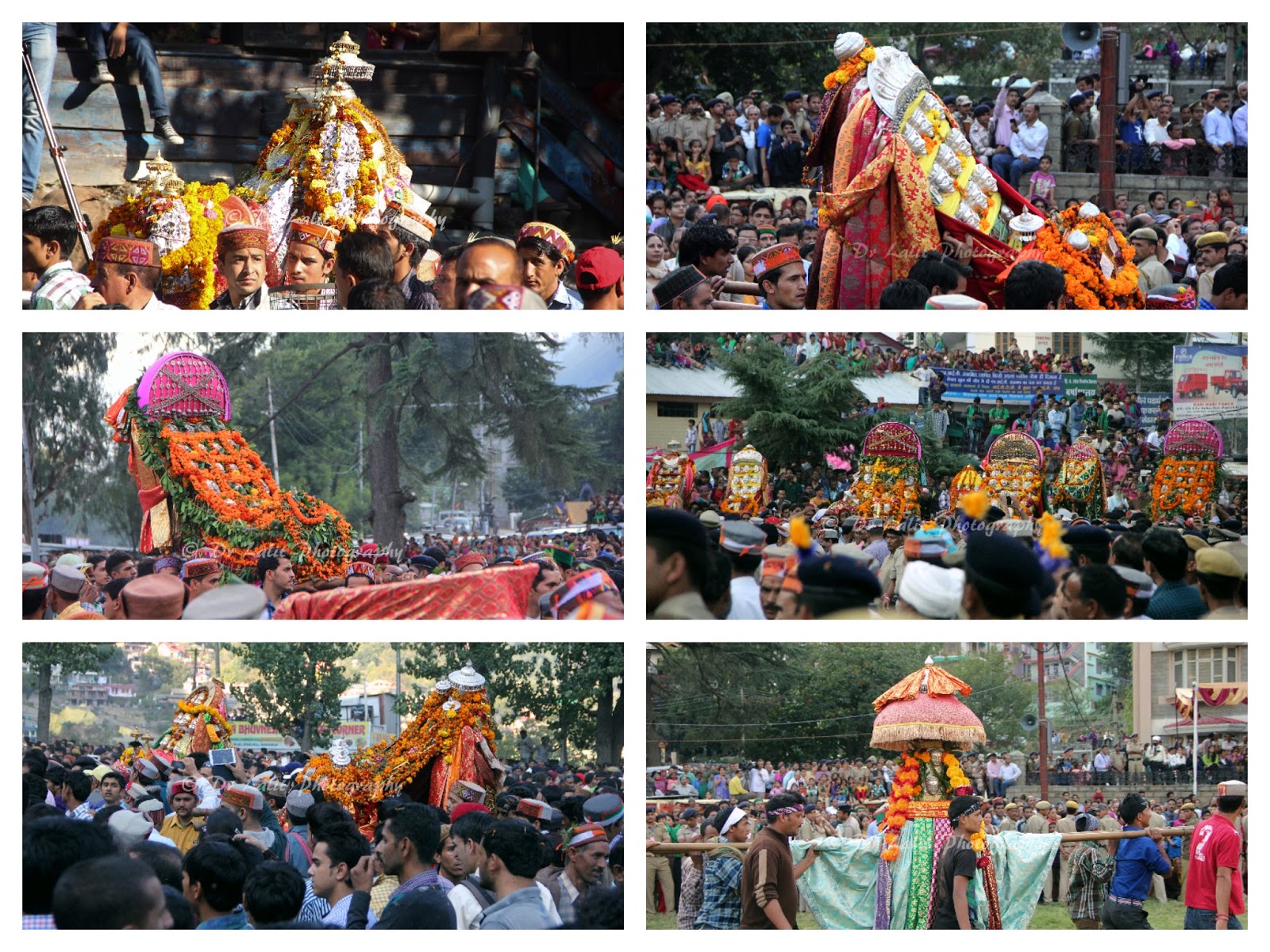Kullu Dussehra is however, different in certain ways from
Dussehra celebrations in the other parts of the country. It presents cultural
ethos of the people and their deep rooted religious beliefs which manifest
during this festival with traditional songs, dances and colorful dress. It
begins on Vijya Dashmi and lasts for a week. During the festival more then 250 idols from all over the kullu valley and adjoining Mandi district, make their way from local village temples to pay obeisance to Lord Raghunatha, the presiding deity of Kullu Dussehra. This year the festival will be celebrated from Oct. 4, 2014 to Oct. 10, 2014.
The beginning of Dussehra in Kullu dates back to the regime of Raja Jagat Singh who ruled Kullu from 1637 to 1672. It all started back in 1637 A. D. when Raja Jagat Singh was the ruler of the Valley. One day he came to know that a peasant Durga Dutt of village Tipri owned beautiful pearls, which the Raja wanted to obtain. Durga Dutt tried to convince the Raja by all means that the information was wrong and that he owned no pearls, but all his pleas were in vain. The Raja gave him a last chance. Durga Dutt got so scared that he burnt down his own family and house and cursed the Raja for his cruelty. Sitting by its side, he cut his flesh with a sharp blade at every leap of the fire and vowdily cursed the Raja for his unjurt demand by saying "Have the pearls, O' Raja".
After
a laps of sometimes it so happened that the Raja was haunted by the spirit of
the innocent Brahmin family, stung by the qualms of the conscience, he felt
every moment the painful and tearing pinch of the strings and arrows of the
deadly sin committed by him. Under guilt conscious and hallucination he used to
see crawling worms in place of rice and human blood in place of water in the
tumbler. The Raja did whatever he could do but of no avail. The news of his
illness spread throughout his kingdom and all possible means of curing his
disease were explored by his courtiers, prominent hakims, vaids and
religious persons saints etc. But nothing could stop Raja's
hallucinations. At last a Bairagi named Krishan Dutt (Pahari Baba) offered his
counsel that no medicine can be effective to cure the Raja except the blessign
of lord Rama.
In this direction he further suggested that the Raja should take
charanamrit of an idol of lord Rama. This idea struck sound in the mind of the
Raja and further efforts were made to procure a holy idol from Ayodhya. His
efforts succeeded in procuring a genuine idol from Ayodhya. For this work a
disciple of Bairagi Krishan Dutt name Damodar Dass was selected and deputed for
this purpose. Damodar Dass had attained miraculous power known as 'Gutka
Sidhi'. Through this miraculous power he was able to procure the rare piece of
Rama's idol alongwith Pujari from 'Tret Nath' Temple of Ayodhya in 1651 AD
which was installed in Raghunathjee's temple at Sultanpur Kullu by obersving
all the rituals suggested by the learned priests of that time. It may be of
interest to record here that a special class of priests were brought from
Ayodhya to conduct the rituals and their descendants still continue to keep-up
the tradition.
On the first day when the Dussehra fair begins, the idol of Raghunth ji saddled in a gaily attired Rath is pulled from its fixed place in Dhalpur Maidan, to another spot across the maidan by big ropes by the local people. The village gods more than one hundred in number mounted in colorful plaquine attend this fair. There after for seven days the fair goes on.
On the first day when the Dussehra fair begins, the idol of Raghunth ji saddled in a gaily attired Rath is pulled from its fixed place in Dhalpur Maidan, to another spot across the maidan by big ropes by the local people. The village gods more than one hundred in number mounted in colorful plaquine attend this fair. There after for seven days the fair goes on.
On the 6th day, the assembly of Devtas takes
place. All the village gods attending the fair with their followers and band of
musicinas participate in the assembly. It is an impressive and rare scene to
witness. Devtas sitting together in colorful attires round the camp of
Raghunathji. On the concluding day, the Rath is again pulled near to the bank
of the river Beas, where a pile of thorn bushes is set on fire that symbolises
the burning of Lanka. Some animals are sacrified and Rath is brought back in a
procession to its original place. Raghunathji is carried back to his temple at
Sultanpur. The attending gods disperse and so the people.
Copy Right: Dr Lalit Mohan
Dr Lalit mohan acknowledgehttp://hpkullu.nic.in





No comments:
Post a Comment